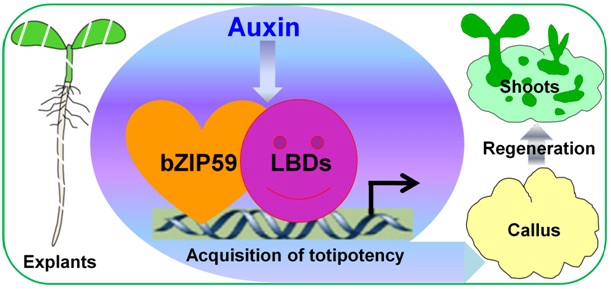Plant cells have long been considered to have remarkable regeneration capability, which is the fundamental basis for plant in vitro regeneration. The plant regeneration system has been well established in many plant species and extensively employed in agricultural practice and gene transformation for more than half a century.
Callus induction is an initial step for a typical plant in vitro regeneration system, which is driven by phytohormone auxin and occurs via a root developmental pathway, a process similar to the induction of pluripotent stem (iPS) cells in mammals. However, the molecular mechanism underlying auxin-induced callus induction in plants remains largely elusive.
The research team led by Prof. Yuxin Hu from Key Laboratory of Plant Molecular Physiology, Institute of Botany, Chinese Academy of Sciences, previously identified that the Arabidopsis LBD (LATERAL ORGAN BOUNDARIES DOMAIN) transcription factors act as key regulators in auxin-induced callus formation.
Recently, they reported that Arabidopsis basic region/leucine zipper motif 59 (AtbZIP59) transcription factor forms complexes with LBDs to direct cell reprogramming of auxin-induced callus formation. They show that auxin stabilizes AtbZIP59 and enhances its interaction with LBD.
Similar to LBDs, suppression of AtbZIP59 function inhibits the callus induction, while overexpression of AtbZIP59 is sufficient to trigger the spontaneous callus formation without exogenous phytohormone.
Using root meristem-specific markers, they also found that AtbZIP59-directed callus formation resembles the callus induction by ectopic activation of root development program. AtbZIP59 and LBD16 act synergistically in directing cell fate change, and that AtbZIP59-LBD16 directly targets a FAD-binding Berberine (FAD-BD) gene and promotes its transcription, which contributes to callus formation.
These findings define AtbZIP59-LBD complex as a critical regulator of auxin-induced cell fate change during callus formation, which provides the new insight into the molecular control of plant regeneration and possible developmental programs.
This work establishes a detailed molecular link between auxin signaling and cell reprogramming of callus induction in plant regeneration program, and is also helpful to understand the evolutionary diversification in the control of cell pluripotency between plant and animal kingdoms.
This finding has been published in Nature Plants in an article entitled "Control of auxin-induced callus formation by bZIP59-LBD complex in Arabidopsis regeneration". Their another work entitled "Genome-wide identification of Arabidopsis LBD29 target genes reveals the molecular events behind auxin-induced cell reprogramming during callus formation" has also been published in Plant and Cell Physiology.
These works were supported by the National Natural Science Foundation of China, the Ministry of Science and Technology of China, and the Strategic Priority Research Program of Chinese Academy of Sciences.

A proposed model for auxin-induced callus formation in Arabidopsis regeneration (Image by HU YX)
Articles link:
https://doi.org/10.1038/s41477-017-0095-4
https://doi.org/10.1093/pcp/pcx168
Contact:
Prof. Yuxin Hu
Key Laboratory of Plant Molecular Physiology, CAS
Institute of Botany, Chinese Academy of Sciences,
20 Nanxincun, Xiangshan, Beijing 100093, China
E-mail: huyuxin@ibcas.ac.cn
Plant cells have long been considered to have remarkable regeneration capability, which is the fundamental basis for plant in vitro regeneration. The plant regeneration system has been well established in many plant species and extensively employed in agricultural practice and gene transformation for more than half a century.
Callus induction is an initial step for a typical plant in vitro regeneration system, which is driven by phytohormone auxin and occurs via a root developmental pathway, a process similar to the induction of pluripotent stem (iPS) cells in mammals. However, the molecular mechanism underlying auxin-induced callus induction in plants remains largely elusive.
The research team led by Prof. Yuxin Hu from Key Laboratory of Plant Molecular Physiology, Institute of Botany, Chinese Academy of Sciences, previously identified that the Arabidopsis LBD (LATERAL ORGAN BOUNDARIES DOMAIN) transcription factors act as key regulators in auxin-induced callus formation.
Recently, they reported that Arabidopsis basic region/leucine zipper motif 59 (AtbZIP59) transcription factor forms complexes with LBDs to direct cell reprogramming of auxin-induced callus formation. They show that auxin stabilizes AtbZIP59 and enhances its interaction with LBD.
Similar to LBDs, suppression of AtbZIP59 function inhibits the callus induction, while overexpression of AtbZIP59 is sufficient to trigger the spontaneous callus formation without exogenous phytohormone.
Using root meristem-specific markers, they also found that AtbZIP59-directed callus formation resembles the callus induction by ectopic activation of root development program. AtbZIP59 and LBD16 act synergistically in directing cell fate change, and that AtbZIP59-LBD16 directly targets a FAD-binding Berberine (FAD-BD) gene and promotes its transcription, which contributes to callus formation.
These findings define AtbZIP59-LBD complex as a critical regulator of auxin-induced cell fate change during callus formation, which provides the new insight into the molecular control of plant regeneration and possible developmental programs.
This work establishes a detailed molecular link between auxin signaling and cell reprogramming of callus induction in plant regeneration program, and is also helpful to understand the evolutionary diversification in the control of cell pluripotency between plant and animal kingdoms.
This finding has been published in Nature Plants in an article entitled "Control of auxin-induced callus formation by bZIP59-LBD complex in Arabidopsis regeneration". Their another work entitled "Genome-wide identification of Arabidopsis LBD29 target genes reveals the molecular events behind auxin-induced cell reprogramming during callus formation" has also been published in Plant and Cell Physiology.
These works were supported by the National Natural Science Foundation of China, the Ministry of Science and Technology of China, and the Strategic Priority Research Program of Chinese Academy of Sciences.

A proposed model for auxin-induced callus formation in Arabidopsis regeneration (Image by HU YX)
Articles link:
https://doi.org/10.1038/s41477-017-0095-4
https://doi.org/10.1093/pcp/pcx168
Contact:
Prof. Yuxin Hu
Key Laboratory of Plant Molecular Physiology, CAS
Institute of Botany, Chinese Academy of Sciences,
20 Nanxincun, Xiangshan, Beijing 100093, China
E-mail: huyuxin@ibcas.ac.cn
